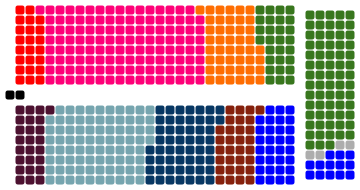1925 Kyotakavian general election
This article is incomplete because it is pending further input from participants, or it is a work-in-progress by one author. Please comment on this article's talk page to share your input, comments and questions. Note: To contribute to this article, you may need to seek help from the author(s) of this page. |
| ||||||||||||||||||||||||||||||||||||||||||||||||||||||||
All 535 seats to the Legislative Assembly 268 seats needed for a majority | ||||||||||||||||||||||||||||||||||||||||||||||||||||||||
|---|---|---|---|---|---|---|---|---|---|---|---|---|---|---|---|---|---|---|---|---|---|---|---|---|---|---|---|---|---|---|---|---|---|---|---|---|---|---|---|---|---|---|---|---|---|---|---|---|---|---|---|---|---|---|---|---|
| Turnout | 92.68% ( | |||||||||||||||||||||||||||||||||||||||||||||||||||||||
This lists parties that won seats. See the complete results below. | ||||||||||||||||||||||||||||||||||||||||||||||||||||||||
| ||||||||||||||||||||||||||||||||||||||||||||||||||||||||
Legislative Elections were held in the Svozgardan protectorate of Kyotakavia on the 1st January 1925 to elect all 535 representatives of the Kyotakavian Assembly, as well as 10 of the 30 State Ministers in the Kyotakavian Senate. Kyotakavian Representatives are elected from 110 First Past the Post Constituencies, 400 Proportional Seats and 25 Svozgardan reserved seats whilst State Ministers are elected through an STV election in the state. To qualify for Proportional Seats, a party must reach 3.00% of the vote.
The result was a landslide 10.6 swing to the Kyotakavian United Syndicalist and Socialist Coalition. This swing came largely from the three traditional parties of government, the Workers' Party, Populists and the Traditionalists all who suffered catastrophic losses in seats though it is important to note that a large amount of the Syndicalist vote came from new voters who had not participated in the last few elections. Parties on the fringes of politics, specifically the KPK and the Front saw substantial increases in their vote share and more than doubled their representation in the Assembly. The NLP also saw a large upswing in support, restored to significant political position for the first time since the Second War of Kyotakavian Independence with the victory being especially significant for them as two gains were Constituency Seats from the SLA in the ethnically diverse towns of Nowa Grudak and Soborski.
The election was remarkable for several reasons, first the significant victory of the Syndicalist Party under Johaan Calstaunas which was the highest vote share and largest seat count ever won by a party at an election for the Legislative Assembly. Whilst a successful election had been predicted at the start of campaigning, Calstaunas was noted as a particularly charismatic speaker for the Syndicalist Party, as well as a record as a very young party moderate and determined nationalist that analysists believe endeared him to many voters who may have not otherwise supported the KUSSC. The turnout for this election was also the highest seen, with nearly 93% of the nation voting, contributing significantly to the strong electoral performance of fringe parties and the KUSSC. The Svozgardan Loyalist Alliance, for the first time either as themselves or as the King's Representation Committee, lost every seat they held except for the 25 reserve seats that they were assured under the Constitution.
Initially, little particular attention was paid to the government formation process as mathematically Alliance, the Workers' Party and KUSSC had 268 seats and could be expected to govern with small concessions to the Independents in the Assembly, despite this, the KUSSC instead chose to align with the NLP. The government therefore represented a major political coalition of Nationalist parties, and after approval from all participants, it was widely considered that this political move anchored the Government along lines of strict opposition to the SLA and to the national Svozgardan government.
Background
The Populist-Traditionalist government of Stefan Kobovic had lead the national picture of Kyotakavia for a decade with two successive election wins for the parties of government. Reliant on the abstention of the SLA from none-constitutional issues, the parties had become increasingly unpopular, seen as "collaborators" with the Svozgardan government due to their reliance on the SLA for the government to continue to operate. Despite this, until late 1924, there didn't seem to be a reliable political threat to the incumbent government as whilst losses were predicted, the continued ill fortune of the Workers' Party meant that it was unlikely to be that there was significant enough electoral threat.
Results
| Party | Votes | % | Proportional | Constituency | Total | ||||||
|---|---|---|---|---|---|---|---|---|---|---|---|
| Seats | Seats | Seats | ± | ||||||||
| KUSSC | 5,542,172 | 24.97% (+13.54) | 101 | 27 | 128 | +69 | |||||
| Alliance | 4,299,006 | 19.37% (+4.08) | 78 | 19 | 97 | +20 | |||||
| Populists | 3,496,820 | 15.75% (-7.62) | 65 | 18 | 83 | -40 | |||||
| Traditionalists | 2,158,366 | 9.72% (-9.17) | 41 | 13 | 54 | -45 | |||||
| Workers' Party | 2,196,038 | 9.89% (-7.08) | 41 | 4 | 45 | -39 | |||||
| NLP | 2,034,271 | 9.16% (+4.25) | 38 | 7 | 45 | +19 | |||||
| The Front | 963,952 | 4.34% (+2.30) | 19 | 12 | 31 | +25 | |||||
| KPK | 886,393 | 3.99% (+1.36) | 17 | 6 | 23 | +19 | |||||
| SLA | 620,475 | 2.80% (-1.66) | 25 | 0 | 25 | -26 | |||||
| Independents | N/A | N/A | 0 | 4 | 4 | -2 | |||||
